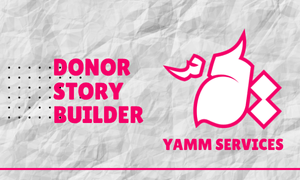You know the rule: great donor stories aren’t about making the donor the hero. But if they’re not the hero, what role do they play?
They are the most powerful witnesses and helpers your cause could ever ask for.
A donor’s voice, used effectively, is a trusted, relatable invitation. It shifts the focus from “look what I did” to “look what we can do, together.” This is the key to building a loyal community of like-minded supporters. It is also at the core community-centric storytelling principles.
Part 1: Understanding the Donor’s Core Motivation
What do donors need? Why do they give? We need to understand our supporters, before we can ask others to join in. Stories help us step into their shoes, how they see hope, care, and change. When someone gives, they act on values. Your story shows that action reshaping their view of the future.
Your current approach is strong:
Great donor stories don’t make donors the hero; they reveal shared values and community change. Start with the donor’s why (the spark), then move quickly to the tension they care about and the one moment they helped unlock.
Practical Shift: Frame the “why” as a moment of recognition. The donor recognized an injustice, recognized a moment of hope, or recognized a piece of their own values in your mission.
Part 2: The Donor as a Trustworthy Witness
The most effective role a donor can play is that of a witness. They aren’t the star, but they are the reliable narrator who can confirm the transformation they saw.
How to Use the Donor as a Witness:
- Focus on Observation, Not Action: Instead of quoting a donor saying, “I wrote a check that funded X,” quote them saying, “I felt the child’s pride as they opened their new book. That was the moment I realized the power of this program.” They are attesting to the impact they observed, validating the community’s success.
- The ‘Before and After’ Testimony: Use their voice to describe the tension they noticed before their involvement and the change they observed after.
- Example: “I used to drive past that empty lot every day and worry about where the kids played. Now, every time I pass, I see the community garden blooming, and it makes my heart feel full.”
Emphasize Shared Values: Ask them about the feeling their gift created. This connects their internal values to the external change. Their witness statement becomes an assurance to their peers: This is a trustworthy and meaningful investment.
Part 3: The Donor as a Humble Helper
A helper is a crucial supporting character who gives the protagonist (the community) the tools they need to succeed. They don’t solve the problem; they enable the solution.

How to Frame the Donor as a Helper:
- The “Unlocked” Moment: Your original point is key: “the one moment they helped unlock.” Their gift didn’t solve hunger; it unlocked the capacity for your partner organization to deliver 50 more meals this week. They are the catalyst, not the cure.
- Keep Program Partners Visible: Name who shaped the work and who is leading transformations. When a donor is a helper, they highlight the protagonists: the resilient family, the leading youth, the innovative volunteer. They shine the spotlight on others.
- Bad: “Our gift gave the single mother a new start.”
- Good: “Our gift provided the funds for Sarah, a powerful single mother who has joined the job training program to start a new career“
- The Invitation: A helper’s final act is to invite others to join the team. They don’t say, “Be like me.” They say, “The work is important, and there is still a need.“
End with an invitation to peers: “If this matters to you, here’s how to join.” This approach builds trust, attracts like-minded supporters, and resists “vanity tales.” Remember: the community is the protagonist; donors are reliable cast members moving the plot forward.
The Practical Checklist for Donor Story Success
Before hitting publish, ensure your story…
- Starts with the Donor’s Why (Recognition): The moment they saw the need or the hope.
- Pivots Quickly to Tension & Community: The focus is on the challenge and the people affected.
- Features the Donor as a Witness: The quote validates the impact (“I saw the change…”)
- Frames the Donor as a Helper: The gift enabled a specific moment of progress.
- Highlights the Protagonists: Staff, partners, and beneficiaries are visible and named (with permission).
- Uses Dignity-First Language: Avoids details that sensationalize hardship.
- Offers Review: If a person is identified, give them a chance to review the piece.
- Ends with a Clear Call-to-Action: An invitation to join a collective effort.
By positioning donors as trusted witnesses and humble helpers, you stop writing stories for them and start writing stories that invite their peers to join the movement.
Download YAMM DONOR
STORY BUILDER
This toolkit provides non-profit professionals with the essential guide, matrix, and checklist to capture and craft powerful donor stories that position supporters as trusted witnesses and crucial Helpers, shifting the focus from individual heroism to collective community transformation.
Author Bio
Ali Zaraket brings over 15 years of experience in nonprofit communication, documentary making and journalism to his role as Lead Communication at YAMM Services Inc..
With a background in journalism and commitment to social activism, Ali is deeply passionate about helping nonprofit organizations effectively communicate their mission and engage with key stakeholders.
Throughout his career, Ali has provided communication strategy and training to hundreds of professionals from a wide range of disciplines. When he’s not working with clients, you can find Ali volunteering for local nonprofits, or spending time outdoors with friends and family.


